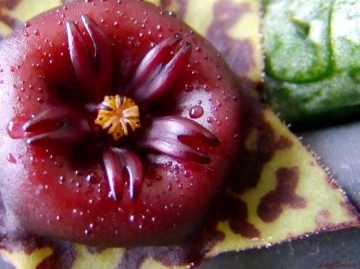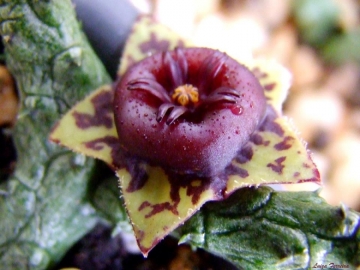




Your support is critical to our success.
Adansonia , n.s. 11(2): 337–339, t. 1, 2 1971 as 'keraudrenae'
Family: ASCLEPIADACEAE

Origin and Habitat: Southwestern Madagascar.
Type locality: Southwestern Madagascar. Betioky district, Ankazoabo gorge.
Altitude range: 50-320 metres above sea level.
Habitat and ecology: Stapelianthus keraudreniaeSN|30599]]SN|30599]] grows on sandstones in the shelter of small bushes.
Synonyms:
Description: Stapelianthus keraudreniaeSN|30599]]SN|30599]] is a remarkable succulent species with creping stems forming dense to diffuse clumps. It is highly priced for its enchanting little flower that look like a brooch with a pearl studded in the centre. The raised annulus resemble some species of Huernia like Huernia zebrinaSN|21240]]SN|21240]] (except for being much smaller). Also, the annulus appears to be viscid or sticky in the absence of dew. As usual. There is considerable variation in colour, particularly from dark to pale red, and the conspicuous, glossy annulus may be spotted or uniformly red. In cultivation it possible to find a crested form with stem tips often cristate/monstruose. In all other characteristics, namely size and shape, flowers, fruits, roots etc. it is very similar to the standard species.
Stems: 2.5-15(-40) cm long, 4-10 mm thick, procumbent or with erect apices, purple-brown flecked on gray-green background, surface bullate. Tubercles broadly flattened-conical, forming 4 or 5(to 7) ribs along stem.
Leaves: Rudimentary 1-2 mm long, narrowly lanceolate, recurved, somewhat flattened above and gradually withering and falling off.
Flower: Facing upward. Pedicel ascending to erect 3-7 mm long, 1.5 mm thick. Sepals 3-7 mm long, 1.5-2.0 mm broad at base, ovate-laneolate, acute, green suffused fainlly with purple. Corolla 20-35 mm across, rotate; outside pale green finely spotted with 3 to 5 raised red/brown longitudinal veins on each lobe, smooth; inside with scattered small obtusely conical usually purple-tipped papillae becoming longest (up to 0.3 mm long) and densest along edges of lobes and in mouth of tube but absent on outer side of annulus (sometimes only along margins of lobes), each tipped with small apical and often obtuse bristle. Annulus glossy, pale red to dark purple-red or densely spotted with red-purple, lobes greenish to dull yellow spotted with wine- to purple-red. Tube c. 3 mm long, 6-8 mm broad, pentagonal, broadly V-shaped. Just containing gymnostegium, thickened into cushion-like raised circular annulus around mouth. Corolla lobes 7-10 mm long, 8-12 mm broad at base, ascending to spreading or recurved, ovate, pointed, usually with reflexed tips. Corona 3.0-4.5 mm tall, 5-6 mm broad, red to dark maroon, shiny, seated on very short stipe. Outer lobes 3.0-4.5 mm long, 2-3 mm broad, erect, spreading above close to mouth of tube, slightly concave outside and convex within, bifid in upper quarter to third into obtuse spreading to reflexed lobules. Inner lobes c. 0.6 mm long, shorter than anthers, oblong-linear. The flowers emit a faint unpleasant odour of excrement, and some drops of nectar-like secretion are sometimes found on the annulus.
Fruits: The fruit are paired spindle-shaped capsules (follicles), resembling the horns of an antelope, with the tightly packed seeds inside.
Seed: 5 mm long, 2.5 mm wide, pear-shaped with a swollen pale border, rest pale brown.
Chromosome number: 2n = 22
Bibliography: Major references and further lectures
1) Bosser, J. & P. Morat. 1971. "Sur deux Asclépiadacées nouvelles du sud de Madagascar." Adansonia, n.s. 11(2): 337–342.
2) Hardy, D. S. 1981. "Further notes on the genus Stapelianthus." Asclepiadaceae 22: 2.
3) Walker, C. C. 1979. "Stapelianthus, an introduction". Asclepiadaceae 17: 5–8.
4) Bruyns, P.V.; Klak, C. 2004: "Revision of the Madagascan endemic Stapelianthus (Apocynaceae) based on molecular and morphological characters." Annals of the Missouri Botanical Garden, 91(3): 410-437.
5) Focke Albers, Ulrich Meve “Illustrated Handbook of Succulent Plants: Asclepiadaceae” Volume 5 Springer, 2002
6) Court, “Succulent flora of southern Africa”, A.A. Balkema, Rotterdam 1981

Stapelianthus keraudreniae Photo by: Luiza Ferreira

Stapelianthus keraudreniae Photo by: Luiza Ferreira
Cultivation and Propagation: Stapelianthus keraudreniaeSN|30599]]SN|30599]] is a xerophytic plant adapted to dry soils, but despite its provenance it is without doubt an easy species to grow and not difficult as commonly supposed only bearing in mind that this species benefits from slightly warmer winter than others. Being a sub-tropical stapeliad, it adapts well under tropical conditions.
Growth rate: It is a relatively rapidly growing and easily flowering species that will make large clumps given the best conditions. Most plants will offset readily, and clumps can be produced in a few years.
Soils: It likes very porous mineral cactus mix soil, but can become too elongated if compost is too rich.
Repotting: This plant needs plenty of space for its roots, repotting should be done every other year or when the it has outgrown its pot. Use pot with good drainage.
Watering: It needs regular watering, especially during the hottest summer days; provide also some light watering if the green house temperatures in winter are elevated. Either excessive or very scarce watering can induce rot. During watering took care to avoid wetting the flowers.
Fertilization: Feed with a high potassium fertilizer in summer.
Frost Tolerance: For safe cultivation it is best to avoid freezing temperatures (minimum 5° C). In the rest period no high atmospheric humidity!!
Sun Exposure: Best for half-shade but grow well in full sun and full shade too. Tends to bronze in strong light, which encourages flowering, but is likely to suffer from sun scorch or stunted growth if over exposed to direct sunlight during the hottest part of the day in summer.
Diseases: This species is relatively resistant to cryptogamic diseases than others and is quite resistant to the “Balck spot” disease of Asclepiads. Rot it is only a minor problem with Stapelianthus if the plants are watered and “aired” correctly. If they are not, fungicides won't help all that much.
Uses: It is an excellent plant for container growing. Cascading, clustering, great for a hanging display. Stems may possibly become purple and limp in winter, but revitalize in early spring. It always looks good and stays small. It look fine in a cold greenhouse and frame or outdoor in a rockery.
Propagation: Seeds and cuttings. Cuttings will root only in hot weather. Cuttings must be kept very dry to root. Seeds germinate readily if they are sown when fresh.
| Your Actions | |
|---|---|
| Back to Stapelianthus index | |
| Back to Asclepiadaceae index | |
 |
Back to Succulents Encyclopedia index |
Privacy stantement - Terms and conditions - How to cite - About us - Feedback - Donate




